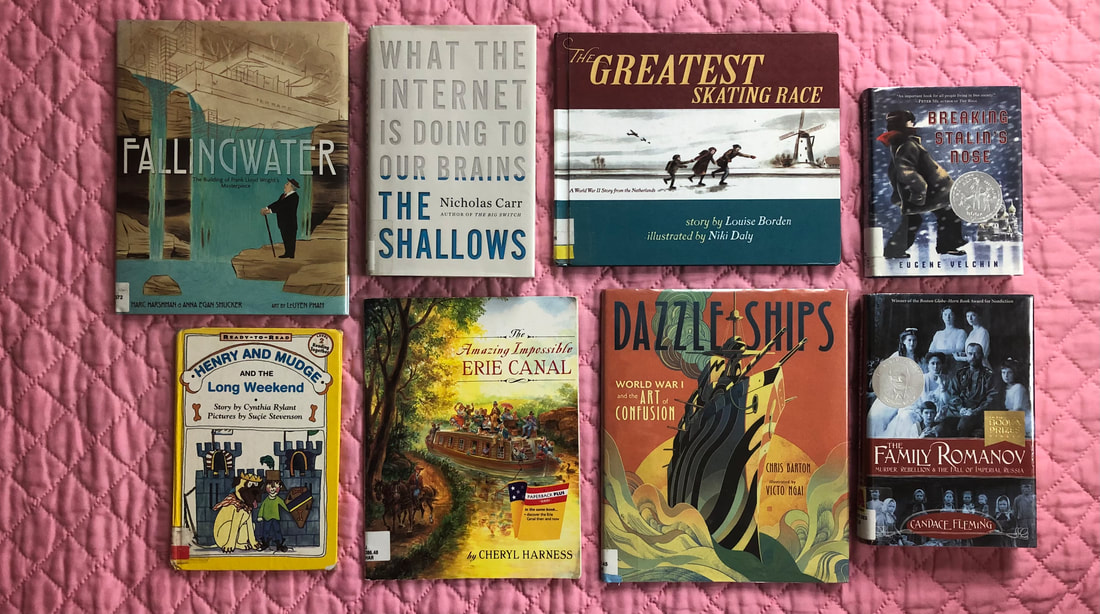|
We swim, in this information age, in an almost bottomless pool of potential learning. Podcasts, online lectures, streaming services, and instant media coverage of news items large and small can overload us. In fact, the greater the pool of knowledge, the smaller our own knowledge seems to be. The books in this issue of Endpapers may help you cut ties with this endless web of clickbait.
The first selection, a nonfiction book highly recommended for older teens and adults, will challenge your engagement with this rather new thing we call the internet. The second set of books is meant to convince you that bite-sized nonfiction aimed at children can sometimes be just the right amount for readers of any age. And the final book, an early reader for little ones, reminds us that simple is so good. Nonfiction for Big-ish Kids (and Grown-ups) You're reading this review on a screen, probably a very small one in your hand. And you probably don't want to read any further. You're itching to move on. Nicholas Carr unpacks why this is true for you and it's scary. The Shallows: What the Internet is Doing to Our Brains by Nicholas Carr has been out for thirteen years and it feels both prescient and timely. Carr argues that our internet-sourced ability to find tiny nuggets of information leads us away from the practice of deep reading. Worse, we actually become unable to do it. If you have the attention span to read this book (oh, the irony), your eyes will be opened. I cannot recommend this book enough to any internet user. History for Middle-ish Grades I have often learned the most about history from children’s books. If well illustrated, a picture book can make a slice of history memorable in a way that even the most engaging adult version often cannot. A few examples stand out in our recent reading at home. Dazzle Ships by Chris Barton taught us about a unique war tactic of the First World War that was completely new to me. Painting sea vessels to camouflage with the ocean itself: sound like the stuff of cartoons? Nope. It was a valid sea-faring defense plan. This book led to a fun painting project for our homeschool that week. The Amazing Impossible Erie Canal by Cheryl Harness provides impressive depth for a picture book. Maps and diagrams intersperse with regular illustrations to bring canal construction and the specific success of the Erie Canal to life on each page. Fallingwater by Mark Harshman offers a light introduction to Frank Lloyd Wright and his architectural highlight found right here in Pennsylvania. This book doesn’t dwell heavily on Wright’s life (which is not a model of virtue), but discusses the architectural ingenuity of this landmark structure built in the 1930s. As an introduction to artistic architecture, it’s worthy of a read. The Greatest Skating Race by Louise Borden is fiction but provides a glimpse into what life may have been like in the Netherlands during WWII. Three children use the frozen canals of Holland to find safety in the face of Nazi oppression. Sweet characters and charming illustrations make this long-ish picture book an enjoyable read-aloud for elementary kids, or a quick one-sitting read for middle schoolers. Picture books can offer more than meets the eye, but for a deep dive, more is obviously required. After scratching the surface of Russian history over this past year, I became slightly obsessed with the topic and spotlighted that piece of history in my own reading. Here are a few books I found helpful. The Family Romanov by Candace Fleming follows the collapse of Czar Nicholas’s power alongside the rising drama of WWI and the simultaneous crescendo of Russian cry for self-rule. Told in story form, with plenty of direct quotes from the historic figures, the book made for an engaging read, despite the inescapable heartbreak. Every element lent a new facet to the story, reminding readers that history does not happen in a vacuum. Breaking Stalin’s Nose by Eugene Yelchin looked like a good possibility for my third-grader: a chapter book, but with illustrations. I found the themes a bit too heavy and decided not to pass it along to him, but I did appreciate it as an eye opening read about life in Communist Russia. Not gruesome, but dark. Worth reading for the historical context, perhaps along with your middle-grade child. Reading for Small-ish Ones The Henry and Mudge series by Cynthia Rylant is dear to our hearts as a family with a Henry of our own. But aside from that favoritism, these early reader books are still darling. Henry and his huge, slobbery dog Mudge are always learning new things in the best possible settings of love and fun. Henry and Mudge and the Long Weekend is a special favorite in our home, but grab any book in the series for your emerging reader and you won’t be disappointed.
0 Comments
|
curated by Brittany Mountz
English major and unsuspecting English educator at ALC Archives
May 2024
Categories |

 RSS Feed
RSS Feed